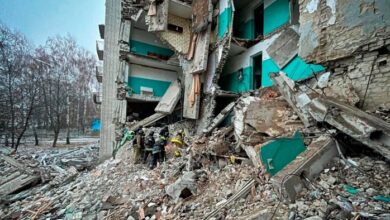Middle East on the brink of ‘oil war’?
Israel is considering an attack on Iran’s energy sector, a retaliation option that has shaken markets and raised concerns that war in the Middle East could threaten global oil supplies.
Any Israeli attack disrupts Tehran’s operations Exports 1.7 million barrels of oil per day would have consequences for global energy markets – while any retaliation by Iran targeting rival oil exporters in the Middle East would cause even more turmoil.
Such an unchecked cycle of attacks, analysts say, risks sending prices of the world’s most essential goods skyrocketing, fueling inflation and damaging the global economy for several years. weeks before the US election. But they said there were mitigating factors that suggested an underlying recovery in the market.
Will Israel attack Iran’s energy infrastructure?
Israel has discussed attacks on Iran’s oil industry with its US allies as it considers the possibility of responding to Tehran’s firing of 180 missiles at Israel this week.
When Iran launched a well-reported missile and drone attack on Israel in April, Prime Minister Benjamin Netanyahu’s government responded with an attack on an Iranian air base . Neither side sought further escalation.
However, this time, analysts predict that Israel will have a more drastic response, possibly targeting Iran’s important oil and gas industry.
“Israel is in what I call a ‘three eyes for one eye’ regime. I have a feeling the reaction will be much bigger than in April,” said Bob McNally, founder of Rapidan Energy Group and former energy adviser to US president George W Bush.
Washington is expected to urge Israel to limit attacks on Iran’s energy infrastructure. But Israel sees the energy sector as “an ATM for the resistance proxy axis,” said Helima Croft, head of commodity strategy at RBC Capital Markets and a former CIA analyst, referring to the network of war groups. Iran-backed troops in the region.
What locations in Iran could Israel target?
The Islamic republic’s most important energy infrastructure is the Kharg Island export facility, about 25km off Iran’s southern coast, which processes about 90% of the country’s crude oil exports.
“There is a lot of concentrated risk for Iran in Kharg Island, which is essentially the nervous system of the Iranian oil industry,” Croft said.
Samir Madani, chief executive of TankerTrackers.com, which reports on oil shipments, said empty tankers near Kharg have left the area since Iran’s missile attack on Israel.
He said the Iranian national tanker group “seemed to fear an imminent attack by Israel”, adding that such an “overnight evacuation” had never been observed before .

During the Iran-Iraq war of the 1980s, Baghdad threatened to destroy the Kharg facility and targeted tankers departing from the terminal.
According to analysts at Kpler, alternative, less important energy targets could include the Abadan refinery, which accounts for 17% of Iran’s oil refining capacity and 13% of its gasoline supply. according to analysts at Kpler – and the Mahshahr oil terminal. Large oil pipelines and storage facilities near Hormozgan could also become targets.
Citi estimates an Israeli attack on Iran’s minor oil infrastructure could cause temporary output losses of up to 450,000 barrels per day. But an attack on Kharg would result in much larger and more lasting losses, up to 1.5 million barrels per day, or about 1.4% of global consumption.
Attacks on refineries rather than oil fields or export terminals could have less impact on oil prices or even cause oil prices to go down, since Iran would have more crude to sell abroad. .

What can Iran do in response?
In retaliation, Iran and its proxies could seek to internationalize the conflict by attacking energy activities across the region, including those of US companies or their allies. America in the Gulf. Analysts warn any such move would represent a significant escalation.
“The risk is that this is no longer a limited conflict between Israel and Iran. Daniel Yergin, a Pulitzer Prize-winning energy historian, said there is a lot of uncertainty right now. “There might be breasts for tattoos. The danger is that the breasts and tattoos can get a lot bigger.”
In 2019, the US blamed Iran for a sophisticated missile and drone attack on Saudi Arabia’s Khurais and Abqaiq oil facilities, causing more than half of the kingdom’s crude oil production to temporarily halt. affected time. Iran was also blamed for two sabotage attacks on oil tankers in the Gulf that year.
But the rapprochement since Riyadh and Tehran restored diplomatic ties last year means Saudi Arabia is now unlikely to be “at the top of Iran’s retaliatory strike list,” RBC’s Croft said. . The two countries have been in regular contact since a Hamas attack on Israel on October 7 sparked a wave of hostility in the region.
Instead, Iran could push its proxies to increase attacks on oil tankers, disrupting supplies and forcing traffic to be rerouted. Houthi rebels have been in Yemen for months already attack merchant ships in the Red Sea, saying the attacks were intended to support Hamas and the Palestinians.
Jason Bordoff, founding director of the Center for Global Energy Policy at Columbia University, said a “more extreme” scenario would clog traffic through the Strait of Hormuz, the waterway through which one-fifth of a barrel of pepper flows. consume global crude oil passing through each place. day.
During the Iran-Iraq war of the 1980s, Tehran exploited the strait in the so-called tanker war.
In April — when it launched its first direct military attack on Israel from Iranian soil in retaliation for Israel’s attack on its embassy compound in Syria — it seized a ship there. But despite threats from hardliners during a period of high tension, Iran has never blocked traffic through the strait.
Any attempt to close the strait would affect Iran’s exports, which analysts say is unlikely. “I think it is a low-probability event that would be difficult to pull off even if Iran wanted to,” Bordoff said.

What will impact oil prices?
This week’s events have left markets reeling after being relatively quiet, with stagnant demand from China sending prices lower. Brent crude, the global benchmark, rose 8% this week to nearly $78 a barrel.
If the confrontation remains limited to limited air strikes without hitting energy infrastructure, Brent prices are unlikely to rise above $85 a barrel, said Henning Gloystein at Eurasia Group.
But successful Israeli attacks on Iran’s oil assets “will almost certainly push prices above $85 a barrel and possibly up to $100,” he said. “Only if there is major Iranian retaliation that would seriously impact shipping through Hormuz could Brent move much higher.”

Analysts at Citi said a successful attempt to block the Strait of Hormuz, while unlikely, would lead to price increases “far beyond previous record highs,” even if only for a period of time. limited time. Brent’s all-time high was $147.50/barrel in 2008.
Any spike in crude oil prices will eventually affect gasoline costs, which could affect the US presidential election in November. Rising prices could be a liability for Democrats. incumbent owner.
What can stabilize the market?
Countervailing forces absent from previous conflicts will help control prices if the conflict escalates.
Two years of output cuts by Opec+ producers – notably Saudi Arabia and the United Arab Emirates – mean the group has spare capacity of more than 5 million barrels per day, this capacity could be restored if Iran’s supplies were suddenly interrupted.
“It is a cushion of reassurance that is needed in the market as we enter this very dangerous situation,” said Ann-Louise Hittle, vice president of oil markets at Wood Mackenzie.
Western nations also hold significant strategic reserves that could be used to prevent price increases, after reserves were established following the price shocks of the 1970s.
A US-led release following Russia’s full-scale invasion of Ukraine helped cool prices in 2022. But US stockpiles are now at their lowest since the 1980s.
China, the destination for most of Iran’s oil, has been building up its reserves, which could help address any supply disruptions.
America’s abundant shale also provides a buffer, allowing drillers to theoretically quickly ramp up output to keep prices down. But their Wall Street owners will no longer tolerate costly new drilling campaigns.
“We are past that,” said Steve Pruett, chief executive of Texas-based Elevation Resources and head of the Independent Petroleum Association of America. “The capital markets have imposed discipline and the leaders of these companies have accepted that discipline.”





